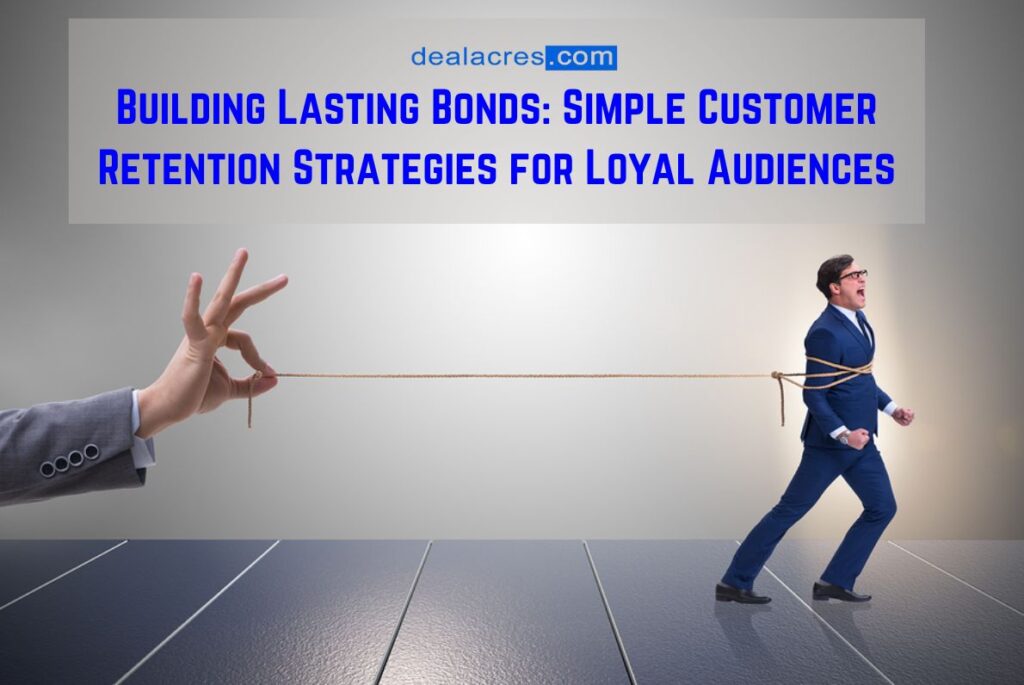Introduction:
In the ever-evolving world of business, acquiring new customers is just the first step. The real challenge lies in retaining them and fostering a sense of loyalty. Loyal customers not only bring repeat business but also become advocates for your brand. In this article, we will explore simple and effective customer retention strategies that businesses, big or small, can implement to keep their audience loyal and engaged.

I. Understanding the Importance of Customer Retention:
1.1 The Cost of Acquisition vs. Retention:
While acquiring new customers is essential, the cost of attracting and converting new leads can be significantly higher than retaining existing ones. Customer retention not only preserves your initial investment but also contributes to long-term profitability.
1.2 Loyal Customers as Brand Advocates:
Loyal customers are not just repeat buyers; they become vocal advocates for your brand. Satisfied customers are more likely to refer your products or services to friends and family, contributing to organic growth and positive word-of-mouth marketing.
II. Providing Exceptional Customer Service:
2.1 Personalized Interactions:
Customers appreciate personalized experiences. Train your customer service team to address customers by their names and tailor interactions based on their preferences and purchase history. Personalization creates a sense of value and care.
2.2 Prompt Issue Resolution:
Addressing customer concerns promptly and effectively is crucial. A quick resolution to problems not only solves the immediate issue but also demonstrates your commitment to customer satisfaction. This can turn a potentially negative experience into a positive one.
III. Building a Customer-Centric Culture:
3.1 Employee Training:
Ensure that your employees are trained to prioritize customer satisfaction. A customer-centric culture starts from within the organization. Empower your team to go the extra mile to make customers feel valued and heard.
3.2 Gathering Customer Feedback:
Regularly seek feedback from your customers to understand their needs and expectations. Whether through surveys, reviews, or direct communication, collecting feedback provides valuable insights for improvement and demonstrates a commitment to continuous enhancement.
IV. Loyalty Programs and Rewards:
4.1 Implementing Loyalty Programs:
Loyalty programs are an effective way to incentivize repeat business. Offer rewards, discounts, or exclusive access to loyal customers. These programs not only encourage continued patronage but also make customers feel appreciated.
4.2 Tiered Loyalty Programs:
Consider implementing tiered loyalty programs with increasing benefits based on customer loyalty. This can motivate customers to reach higher tiers, fostering a sense of achievement and exclusivity.

V. Communication and Engagement:
5.1 Regularly Communicate:
Stay in touch with your customers through regular communication. Use newsletters, email updates, or social media to share relevant information, promotions, and news. Consistent communication keeps your brand at the forefront of their minds.
5.2 Social Media Engagement:
Leverage social media platforms to engage with your audience. Respond to comments, ask for opinions, and run interactive campaigns. Social media is a powerful tool for building a community around your brand.
VI. Surprising and Delighting Customers:
6.1 Unexpected Rewards:
Surprise your customers with unexpected rewards or gifts. This could be a discount on their next purchase, a freebie, or a personalized thank-you note. These unexpected gestures create positive emotions and strengthen the customer-brand relationship.
6.2 Special Occasion Recognition:
Remember and acknowledge special occasions in your customers’ lives, such as birthdays or anniversaries. Sending personalized greetings or offering exclusive discounts during these times shows that you value them beyond their purchasing power.
VII. Streamlining the Customer Experience:
7.1 User-Friendly Processes:
Simplify your processes to make the customer experience seamless. From the online purchasing journey to returns and refunds, a hassle-free experience contributes to overall satisfaction.
7.2 Anticipate Customer Needs:
Proactively address customer needs before they arise. Use data and analytics to understand customer behavior and preferences, allowing you to offer relevant products or solutions before customers even realize they need them.
VIII. Creating a Sense of Community:
8.1 Online Forums and Groups:
Build a sense of community around your brand by creating online forums or groups where customers can connect with each other. This not only fosters a sense of belonging but also provides a platform for customers to share experiences and insights.
8.2 Hosting Events:
Organize events, either in-person or virtually, to bring customers together. This could be a product launch, a workshop, or a simple networking event. Face-to-face interactions strengthen the emotional connection customers have with your brand.
IX. Monitoring and Analyzing Customer Behavior:
9.1 Utilize Analytics Tools:
Leverage analytics tools to monitor customer behavior, track engagement, and measure the success of your retention strategies. Data-driven insights can help you make informed decisions and refine your approach over time.
9.2 Customer Segmentation:
Segment your customer base based on demographics, behavior, or purchase history. This allows you to tailor your retention strategies to specific groups, ensuring that your efforts are targeted and effective.

X. The Long-Term Benefits of Customer Retention:
10.1 Increased Customer Lifetime Value:
Customer retention contributes to increased customer lifetime value (CLV). A loyal customer is likely to make multiple purchases over time, providing a steady stream of revenue that surpasses the value of a one-time transaction.
10.2 Positive Brand Image:
A reputation for excellent customer service and a commitment to customer satisfaction builds a positive brand image. This not only attracts new customers but also strengthens the loyalty of existing ones.
Conclusion:
In a competitive marketplace, retaining customers is as important as acquiring them. Implementing simple and effective customer retention strategies can turn one-time buyers into loyal advocates for your brand. By focusing on exceptional customer service, personalized engagement, and continuous improvement, businesses can build lasting bonds that withstand the test of time. Remember, customer loyalty is not just a transaction; it’s a relationship built on trust, satisfaction, and mutual value.




